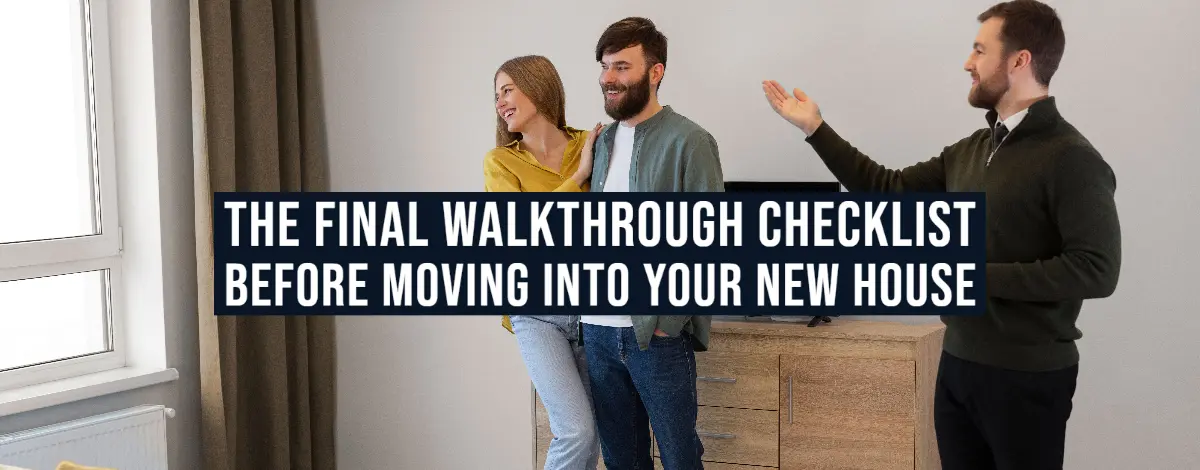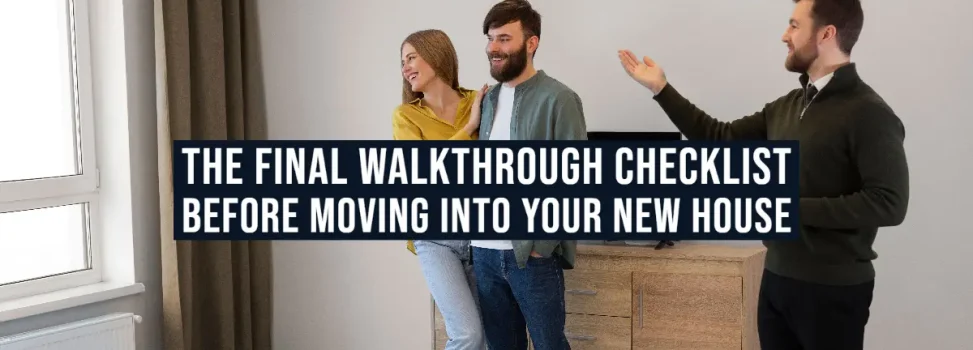Final walkthroughs are equally crucial even though home inspections aren’t them. This is the ideal time for prospective homeowners to view a new house before deciding to buy. This walkthrough’s primary goal is to confirm that the property is exactly as described in your purchase agreement, including all agreed-upon repairs. Additionally, it’s a fantastic chance to make sure nothing has changed with the house since you last visited it.
The Significance Of A Final Inspection
Even though it is not mandated by law, the final walkthrough is one of the most crucial procedures in purchasing a new house. Homebuyers can ensure that everything matches what they think they’re buying by conducting a final tour. It’s your last chance to check that nothing went wrong when the prior owner left the property. It’s crucial to confirm whether any repairs were required as a condition of the deal being finalized.
The final overview is your only chance to examine the house between the initial viewing and property examination and the time they take ownership. Consequently, it ensures that you’re taking the house under the conditions you decided upon at closing.
Guidelines For The Ideal Final Walkthrough:
It’s normal to experience pressure to complete your walkthrough quickly. To get the most out of your tour, keep these suggestions in mind.
1. Determine Who Is Present For The Walkthrough:
The purchaser and the buyer’s agent usually attend the last walkthrough. But it’s uncommon to see the seller or the seller’s representative there. As a result, the buyer can view the home at their convenience and without feeling rushed. But remember that the last visit is not a house inspection. Therefore, don’t count on having any engineers or architects join you for the walkthrough.
2. Plan It For Right Before You Leave:
The final walkthrough can often be scheduled for around 24 hours before the sale date. When you observe the house empty, collaborate with the agent who represents you and the seller’s agent. You might have trouble spotting any minor faults or challenges that could be overlooked when you arrange a tour when the house is still utilized.
3. After Inclement Weather, Perform An Additional Walkthrough.
If terrible weather happens just before closure, it might sound strange, but try to plan another walkthrough. Performing the tour will enable you to look for damage that was missed during the first one, such as water incursion, sinkholes, or other issues.
4. Express Newly Discovered Problems:
Understand that not every serious issue you discover during the final walkthrough has to be a deal-breaker. Bringing up these concerns with the seller and your agent may cause a brief interruption in the closing, but it will give them time to fix the situation. If anything, you might be able to request a closing credit from the seller, so you can take care of the repairs after the scheduled move-in date.
The Complete Check-List For The Final Inspection
It could be an excellent choice to print up a walkthrough schedule and carry it with you on the actual day of the ultimate walkthrough to ensure you don’t miss anything. Continue reading for some important considerations for the walkthrough.
The Interior Of The Home:
Verify The Door Locks And The Window:
Verify for sure that the locks and unlocks on all the windows and doors work properly. Make sure the windows are easy to open. Additionally, make sure the window screens are free of flaws, tears, or holes. Before moving in, you should make sure your house is comfortable and at ease. Verify the door locks and the window latches. You should also take notice of any missing window screens and any windows that stick or are damaged, as these could pose a fire threat.
Double-Check The Appliances:
Make sure every home appliance is operating as it should. Every appliance in the house, including the bathroom fixtures, bathtubs, and sinks, should be checked, as well as the washer, dryer, and trash disposal. Start inspecting the electronics in the kitchen. Double-check that the dishwasher can run a complete cycle and the oven warms up (without smelling like gas). After that, proceed to the laundry facility to turn on and off the washer and dryer. If there is a utility sink, put something in it and check the drainage. Be sure to catch any more home furnishings if there are any.
Check For Mold Or Other Issues In The Places That Are The Wettest:
Keep a close eye out for mold in the fridge, sink cabinets, baths, and toilets. Check for mold or other issues in the places that are the wettest. Verify that there is no mold, water damage, or standing water around the washbasin, shower, or toilet bottom in the bathrooms. Even if you didn’t find any during your inspection, it’s still important to take a detailed check because mold can appear in a couple of days. Keep in mind the toilets aren’t running by testing them as well. Check that the water is hot, that no water sprays out when you turn on the taps (including the bathtub), and that there are no leaks when you turn the taps off. Every tub and washbasin should drain swiftly and effectively.
Examine The Electrical Part:
To make sure there are no indications of damage, inspect every one of the electrical wiring and power sources, including any plate covers. By turning on and off the lights, inspect the power grids. Also, ensure for sure all outlet plate covers are intact. Then, connect your phone to each outlet to make sure they are all functional. If not, you might have a more serious electrical installation issue that you’ll need to resolve before closing on the house. Additionally, make sure all doorbells, alarm systems, and garage doors function.
Inspect the termites or other pests:
Keep an eye out for pests including rodents, ants, and termites. You must take action if you notice mouse droppings or bite marks from unwanted animals. Verify that no small animals moved in after the seller left. Termites or other pests may be indicated by dry rot, spongy floors, or crumbling wood. Keep an eye out for any mouse droppings or other evidence of little intruders. Your real estate agent can assist you in making decisions about what to do with your discoveries once you have finished your final walk-through checklist. Some problems might be significant enough to be brought up to the seller as things that need to be fixed before closing, while others might just be things you should be aware of before moving in.
The Exterior Of The Home:
- Check the landscaping in the backyard to make sure it is in good shape.
- If the home has a gate, circle the yard to check that it closes and unlatches properly.
- Examine the pool and look for mildew, mold, and lining damage if the residence has a pool. Check the pool gates for damage and note it.
- Confirm that the sprinklers in the house are all functioning properly by checking the irrigation system. Assess the condition of any separate properties, such as garages or guest homes.
- Check that all remote controls function properly and that the parking lot door opens and closes without any problems.
- Confirm and examine any outdoor repairs that were agreed upon during the closure.
Another Point Regarding Walkthroughs:
The last tour before you move into your new house is crucial. Even though it can seem pointless to bring up any issues, you see with the house, speak with your real estate agent to find out your options.
Your last opportunity to find issues with your house and confirm that the seller has completed all repairs is during the final walk-through. Don’t forget anything on your ultimate checklist while you inspect the house, and if you discover any issues, speak with the agent who represented you to determine the most appropriate option for the next step.
Having said that, it’s crucial to keep in mind that there will always be matters you would like to improve or alter in your new property. After you formally purchase a home, you should plan to do some home renovation work on your own. Plan to acquire a quote or advice from an expert if there are undertakings that are outside the realm of your experience.
FAQs About Final Walkthrough Before Moving to New House
The duration of the final walkthrough might range from an hour to several hours, according to the size of the house. Keep in mind that this is your final opportunity to check the house and its content. Delay the walkthrough, thus.
The majority of the final walk-through takes place a few days or even the day before closing. Typically, the walk-through happens after the owner has left the property. The seller may be available for the walk-through if they haven’t completely relocated yet.
The final walk-through is often attended by the purchaser and their property agent only. They might get assistance from the real property broker as they go through. What the purchasers need to search for during the walk-through may be more commonly known to an agent.


